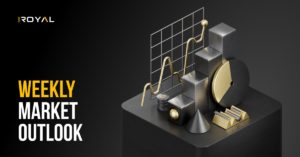US Indices ended the month in losses, and Meta share price changed its direction, supported by AI.
Wall Street indices have ended their sessions on a daily and monthly decrease in light of investors’ rising fears and concerns that interest rates would remain high for a longer period of time. After the strong performance in January, the shares declined in February, as economic data and comments from Federal Reserve officials pushed to reconsider the possibility of the central bank raising interest rates to a level higher than the markets’ expectations.
Traders began anticipating the interest rate changes by 50 basis points in March, although the possibilities are still low at about 23%, and expectations indicate that the rates will reach their peak at 5.4 % by September, up from 4.57 % at the present time.
Bank of America warned that the Federal Reserve might raise interest rates to nearly 6%.
The S&P 500 index fell by 13 points or 0.3 % in Tuesday’s session to close at 3970 points. The index also fell by 2.6% in February, pressured by the increase in the returns of 2-year US Treasury bonds by about 14% in February to 4.81%.
The Dow Jones Index increased by 0.7% or about 232 points at 32656 points, its lowest closure in 4 months. The index moved away from the 50-day moving average. The index closed with a 4.2% decrease for the first time since September 2022.
The Nasdaq index fell 0.1% in Tuesday’s session to close at 11455 points, but it remained above the 200-day moving average levels of 11405. Over the month, the Nasdaq decreased by more than 1% in February after it recorded an increase of about 11% in January, which was previously preserved by gains of more than 9% since the beginning of the year.
Meta’s share is the descending trend of most American stocks in Tuesday’s session. The share was up by more than 3%, recording the highest daily gains in about a month. These rises came after the parent company of Facebook said that it would create a new product group focusing on artificial intelligence. Throughout the month, Meta’s shares jumped about 17% in February, recording a fourth monthly increase.
China’s Manufacturing Purchasing Managers’ Index increased in February to the highest level since April 2012.
The Manufacturing Purchasing Managers’ index rose in China to 52.6 points during February from 50.1 in January, compared to expectations of an increase of 50.5 points, the highest level since April 2012.
Speaking of the index of non -industrial purchasing managers, he jumped to 56.3 points in February 2023 from 54.4 points in January to reach 54.4 points, at the highest level since June 2022.
The Chinese government said that the February reading showed a continuous improvement in the production and business climate, noting that the total size of the activity “increased significantly” as well.
Citi economists said: “The widespread improvements for each of the Industrial and Industrial Procurement Managers Index in February reflects the strong momentum of the recovery after reopening the economy,” CITI economists said.
Economists in Citi added that while the expectations for stimulus policies are low, the Chinese People’s Bank will be “aware of the risks of inflation and may tend to a natural policy once the economy returns to the right track.”
European stocks begin the month of March on stability.
European stocks increased thanks to mining companies and luxury products on Wednesday, March 1, after solid data from China reassured investors of fears of an economic slowdown. BNP Paribas, the largest euro area, fell from the gains.
The European Stoxx 600 index rose 0.2% by 08:12 GMT, starting the month with confidence after a strong start for this year.The shares of luxury product companies such as LVMH, KERING, Pernod Ricard, and Hermès International have also increased, witnessing a significant expansion in China, between 1.7 and 2.1%.
The Japanese Nikkei index closes high as morale improves on the background of Chinese data.
The Japanese Nikkei index strengthened its gains to close on Wednesday, March 1, with morale improving after data on the expansion of manufacturing activity in China in February showed the fastest pace in over a decade. The Nikkei index closed 0.26% at 27516.53 points after falling to 0.5% on the leading indicators in Wall Street earlier in the day. The broader Topix index rose 0.23% to 1997.81 points.
Last night, the Dow Jones Industrial Average fell by 0.71%, the Standard and Poor’s 500 index fell by 0.30%and the Nasdaq index by 0.1%.
China’s Manufacturing Purchasing Managers’ Index jumped to 52.6 last month, a significant difference from analysts’ expectations at 50.5. The Japanese Ajinomoto shares jumped 9.31% after the manufacturer raised its annual profit expectations and announced adopting the policy of distributing upward profits, which supported the standard index. The food and beverage product sector index rose 0.7%. The oil company shares index also increased by 2.81%. The shares of the banking sector fell 0.294% after a 9% rise this year.
Digital currencies are rising, and bitcoin approaches the level of 24 thousand dollars.
Digital currencies, headed by Bitcoin, increased in Wednesday’s trading, despite the recent losses that it witnessed after organizational campaigns that resulted from the collapse of the FTX Stock Exchange.
Bitcoin increased by 2.36% at 23828.50 dollars, at 09:15 GMT, according to Coinbase data. Ethereum increased 1.86% to 1658.38 dollars, and rubles 1.85% to 38.36 cents.
Gold continues to climb as the dollar declines, but the interest rate fears limit the gains.
Gold prices continued to climb to the third session on Wednesday, March 1, as the dollar fell. However, fears of interest rate increases against the backdrop of high inflation worldwide in curbing gains. Gold rose in instant transactions by 0.2% to $ 1831.43 an ounce by 05:36 GMT. US gold futures increased 0.1% to $ 1838.90.
In February, the precious metal recorded its worst month since June 2021 after a series of American data that indicated the elasticity of the economy and the increase in the number of jobs available in the labor market, which raised fears that the US Federal will continue to raise interest rates to reduce inflation. The dollar index fell 0.1%, making the price of the US currency pronounced within reach of buyers from other currencies.
As for other precious metals, silver increased in instant transactions by 0.8% to 21.09 dollars an ounce. Platinum increased by 0.4% to 955.89 dollars, as well as palladium increased by 2% to 1445.03 dollars.
Oil prices rise amid a state of optimism after the release of Chinese data.
Oil prices rose during Wednesday’s trading, with investor morale improved after Chinese data showed the noticeable improvement in Chinese industrial activity; the largest increase in more than a decade. The data issued today showed the rise of the Chinese industrial managing directors in February to its highest level since April 2012, indicating the second-largest economy in the world after abandoning the strict restrictions related to the epidemic. Russia plans to reduce its daily oil production by 500 thousand barrels per day from this month.Brent crude futures increased by 0.54% or 45 cents to $ 83.90 a barrel at 06:06 GMT. The US crude futures for April delivery increased 0.57% or 44 cents at $ 77.49 a barrel.
Disclaimer: This article is not investment advice or an investment recommendation and should not be considered as such. The information above is not an invitation to trade and it does not guarantee or predict future performance. The investor is solely responsible for the risk of their decisions. The analysis and commentary presented do not include any consideration of your personal investment objectives, financial circumstances, or needs.




